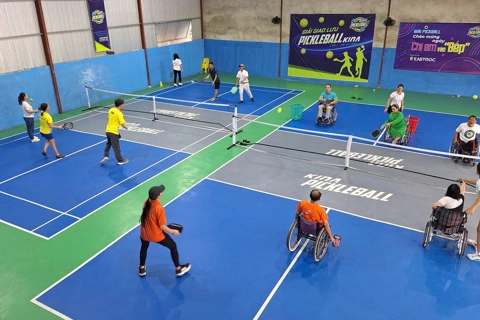Para Natuh Pickleball tournament promotes inclusive sport in Vietnam
The tournament aims to convey the message “Inclusion – Respect – Equality – For Humanity.” It will also offer Vietnamese para pickleball athletes an opportunity to connect with the Paralympic network spanning 206 countries.
18 Dec, 01:35 PMHanoi to spend US$1 billion to upgrade urban drainages, tackle flooding
Hanoi earmarks billion-dollar funding to accelerate drainage upgrades, tackle chronic flooding and climate-driven downpours ahead of intensifying rainy seasons citywide.
17 Dec, 07:09 PMNoi Bai Airport’s expanded international terminal ready for full automation
A full range of automated technologies has been deployed for the first time across Hanoi airport’s international terminal, giving passengers greater control over their journey from check-in to boarding.
17 Dec, 05:37 PMKinh te & Do thi Newspaper presents awards for Hanoi environmental writing contest
A five-year media effort on environmental protection closed in Hanoi on December 17, bringing together journalists, experts and community voices around shared environmental concerns.
17 Dec, 03:50 PMHanoi taps AI, digital data to safeguard consumer rights
Hanoi will expand the use of artificial intelligence (AI), big data and digital platforms to strengthen oversight, support consumers and improve accountability.
17 Dec, 03:24 PMHanoi Culinary Culture Festival 2025 highlights cuisine as key cultural industry driver
The Hanoi Culinary Culture Festival 2025 will bring together artisans, businesses and visitors to celebrate the capital’s rich food heritage while promoting cuisine as a core pillar of cultural tourism and creative industries.
17 Dec, 03:20 PMHanoi Party Committee sets priorities for 2026
The priorities reflect Hanoi’s ambition to modernize governance, sustain economic momentum and position itself as a dynamic, livable and globally connected capital in the years ahead.
17 Dec, 03:12 PMHanoiTex & HanoiFabric 2025 opens, showcasing sustainable textile technologies
The HanoiTex & HanoiFabric 2025 highlights modern machinery and equipment for the textile and garment industry, especially AI robotics technology, to meet the increasingly high demands of the global market.
17 Dec, 03:01 PM








